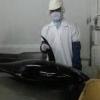Hi ,
Actually sampling is done to assure that coming material is complying with the specifications , so generally we withdraw samples to assure that the coming material will fulfill our requirements and it does not contain any hazards .
accordingly sampling plan depends on Risk assessment for the food safety ,quality , .. depending on the process and the product , I should now first what the expected effect of the deviation accordingly I can determine the sample size and the rejection rate (you can use AQL sampling table ) .
Another parameter is the supplier confidence level , if it is approved supplier and the material risk is low , so you can make sampling for monitoring only ( e.g. each 5 consignment withdraw samples of one consignment , this is called skip sampling ) .
So not all the material is a mater of positive release ( sampling for release criteria ) , some may be for just monitoring , it depends on your history , supplier confidence level (approved suppliers ) , process / raw material risk assessment and what is the effect of the defect on your process /product , sampling plan is case sensitive each of the previous elements affect the sample size , frequency and acceptance level .
Best regards ,
Ehab



















